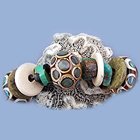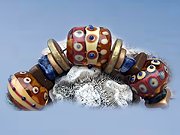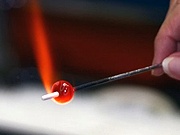Beaded Purses
- Evening Bag Gallery
- Pendant Bag Gallery
- Evening Bag Patterns
- Pendant Bag Patterns
- Complementary Patterns
- Lampwork Beads
- What is Lampwork
- Email Bead Lady
Lampwork Beads
Use the following link to check out my lampwork beads.
Lampwork Beads






What is Lampwork
Lampworking is a type of glasswork that uses a torch to melt rods of glass and manipulates it by use of tools and gravity. Although the art form has been practiced since ancient times, it became widely practiced in Murano, Italy in the 14th century. Early lampworking was done in the flame of an oil lamp, with the artist blowing air into the flame through a pipe - thus the name-lampwork! .
 Lampworking can be done with many types of glass, but the most common are soda-lime glass - sometimes called "soft glass" - and borosilicate glass often called "hard glass." Different colors of glass must be carefully selected for compatibility with each other, both chemically (more of a concern with soft glass than borosilicate) and in terms of coefficient of thermal expansion (COE) Borosilicate glass is considered more forgiving to work with, as its lower COE makes it less apt to crack during flameworking than soda-lime glass. However, it has a narrower working temperature range than soda-lime glass, has fewer available colors, and is considerably more expensive. Also, its working range is at higher temperatures than soda-lime glass, requiring larger torches and the use of oxygen instead of air. In addition to producing a hotter flame, the use of pure oxygen allows more control over the flame's oxidizing or reducing properties, which is necessary because some coloring chemicals in borosilicate glass react with any remaining oxygen in the flame either to produce the desired final color or to discolor if extra oxygen is present.
Lampworking can be done with many types of glass, but the most common are soda-lime glass - sometimes called "soft glass" - and borosilicate glass often called "hard glass." Different colors of glass must be carefully selected for compatibility with each other, both chemically (more of a concern with soft glass than borosilicate) and in terms of coefficient of thermal expansion (COE) Borosilicate glass is considered more forgiving to work with, as its lower COE makes it less apt to crack during flameworking than soda-lime glass. However, it has a narrower working temperature range than soda-lime glass, has fewer available colors, and is considerably more expensive. Also, its working range is at higher temperatures than soda-lime glass, requiring larger torches and the use of oxygen instead of air. In addition to producing a hotter flame, the use of pure oxygen allows more control over the flame's oxidizing or reducing properties, which is necessary because some coloring chemicals in borosilicate glass react with any remaining oxygen in the flame either to produce the desired final color or to discolor if extra oxygen is present.
Lampwork - The Process

Lampworked beads (with the exception of Asian and African beadmaking) have generally been the provenance of Italian, and, later, Bohemian lampworkers for the last four hundred years or so who kept the techniques secret. Thirty or so years ago, some American artists started experimenting with the form. Their early efforts, by today's standards, were crude, as there was almost no documentation, and none of the modern tools. However, they shared their information, and some of them started small businesses developing tools, torches and other equipment. This group eventually formed the basis for the International Society of Glass Beadmakers
Bead Lady Memberships
Southeastern Michigan Glass Beadmakers Guildwww.glassact.org International Society of Glass Beadmakers
www.isgb.org
